Multiple Enhanced Sparse Representation via IACMDSR Model for Bearing Compound Fault Diagnosis
Abstract
:1. Introduction
- (1)
- The pre-processing and post-processing are carried out separately, making them computationally expensive.
- (2)
- The critical parameters of the procedures are required to be specified by humans, demanding a certain degree of expertise and thus with some randomness.
- (3)
- The de-noising capability of these combination methods is inadequate and thus a considerable level of residual noise remains in the extracted fault-induced impulse responses.
- (1)
- The IACMD is not only used to separate compound faults; its extracted fault-induced resonance frequencies can be embedded in a dictionary for sparse decomposition, saving computational cost and ensuring the accuracy of the IACMDSR model.
- (2)
- The IACMD also enables the separation of compound signals without requiring the number of signal components a priori, making it suitable for engineering applications that do not know the number of signal components in advance.
- (3)
- In contrast to popular sparse decomposition dictionaries that adopt the wavelet atoms with a single damping ratio (for example, the Laplace wavelet [23] and the Morlet wavelet [24]) as the basis functions for atoms, this paper employs period-assisted bilateral wavelets with a double damping ratio to form the atoms, which can better match the period-occurred impulse response of bilateral asymmetric attenuation caused by actual faults and thus improve the accuracy of sparse representation.
2. The Framework of IACMDSR Model
2.1. The IACMD Algorithm
2.2. The Improved Sparse Optimization Model
Bilateral Adaptive Wavelet Hyper-Dictionary
3. Fault Diagnosis Procedure Based on IACMDSR Model
- (1)
- The first step is to use the IACMD to adaptively separate the compound fault signal into different fault signal components based on the amplitude of the signal spectrum. The IACMD not only separates the different fault signal components but also extracts the multiple resonance frequencies generated by each fault type.
- (2)
- Second is the design of bilateral adaptive wavelet hyper-dictionary D based on the method mentioned in Section 2.2.
- (3)
- Third is the use of the OMP algorithm and hyper-dictionary to reconstruct each of the signal components decomposed by the IACMD. In which, in order to improve computational efficiency, each signal component is divided into segments, and the length of each segment is . Then, the OMP algorithm is employed to obtain a sparse coefficient matrix . The objective function is shown as follows:Then, the reconstructed signal can be expressed as:
- (4)
- The Hilbert transform and square operation is applied to the reconstructed signal to obtain the squared envelope spectrum. Ultimately, the fault characteristic frequencies can be identified from the envelope spectrum.
4. Simulation Signals and Analysis
5. Application Verification
5.1. XJTU-SY Bearings Compound Fault Data
Comparison and Analysis of Experimental Results
- (1)
- The MCKDSR Model
- (2)
- The MCKDMWF Model
5.2. The Bearing Early Fault Experiment Data
Comparison and Analysis
- (1)
- The MCKDSR Model
- (2)
- The MCKDMWF Model
6. Conclusions
- (1)
- The effectiveness of the IACMDSR model that incorporates IACMD with sparse representation is validated by simulation signals and two sets of experimental signals, and it exhibits better fault extraction performance than the MCKDSR model and MCKDMWF model. These experiment analyses confirm that the IACMDSR model is powerful and has the capability of detecting bearing weak multiple fault features in the presence of heavy noise, which is the Achilles’ heel of the two other leading rival methods.
- (2)
- The performance of the IACMD in extracting fault resonance band is evaluated by the comparison with STFT, CWT, and ACMD, and the comparison results demonstrate that the IACMD exhibits better noise immunity. Additionally, the hyper-dictionary is developed by period-assisted bilateral wavelets, which simultaneously dig deeper into the periodicity and waveform characteristics exhibited by the real fault impulse response. Therefore, it is more suitable for practical engineering applications.
- (3)
- The developed IACMDSR model can be extended to those diagnosis fields such as railway axles, high-speed train gearboxes, as well as engine diagnosis. It is worth pointing out that the IACMDSR has outstanding anti-noise capabilities and self-adaptability. Thus, it is completely suitable for the fault feature extraction of railway bearings with heavy noise and a complex working environment, which can play a significant role in maintaining the safety and comfort of the railway transport system.
Author Contributions
Funding
Institutional Review Board Statement
Informed Consent Statement
Data Availability Statement
Conflicts of Interest
References
- Xu, G.W.; Liu, M.; Jiang, Z.F.; Soffker, D.; Shen, W.M. Bearing fault diagnosis method based on deep convolutional neural network and random forest ensemble learning. Sensors 2019, 19, 1088. [Google Scholar] [CrossRef] [PubMed] [Green Version]
- Hasan, M.J.; Islam, M.M.; Kim, J.M. Bearing fault diagnosis using multidomain fusion-based vibration imaging and multitask learning. Sensors 2021, 22, 56. [Google Scholar] [CrossRef] [PubMed]
- Fan, J.; Qi, Y.S.; Gao, X.J.; Li, Y.T.; Lin, W. Compound fault diagnosis of rolling element bearings using multipoint sparsity–multipoint optimal minimum entropy deconvolution adjustment and adaptive resonance-based signal sparse representation. J. Vib. Control 2021, 27, 1212–1230. [Google Scholar] [CrossRef]
- Li, N.; Huang, W.G.; Guo, W.J.; Gao, G.Q.; Zhu, Z.K. Multiple enhanced sparse representation for gearbox compound fault diagnosis. IEEE Trans. Instrum. Meas. 2019, 69, 770–781. [Google Scholar] [CrossRef]
- Xiong, S.C.; Zhou, H.D.; He, S.; Zhang, L.L.; Xia, Q.; Xuan, J.P.; Shi, T.L. A novel end-to-end fault diagnosis approach for rolling bearings by integrating wavelet packet transform into convolutional neural network structures. Sensors 2020, 20, 4965. [Google Scholar] [CrossRef]
- Ambrożkiewicz, B.; Meier, N.; Guo, Y.; Litak, G.; Georgiadis, A. Recurrence-based diagnostics of rotary systems. IOP Conf. Ser. Mater. Sci. Eng. 2019, 710, 012014. [Google Scholar] [CrossRef]
- Jedliński, Ł.; Syta, A.; Gajewski, J.; Jonak, J. Nonlinear analysis of cylindrical gear dynamics under varying tooth breakage. Measurement 2022, 190, 110721. [Google Scholar] [CrossRef]
- McDonald, G.L.; Zhao, Q.; Zuo, M.J. Maximum correlated Kurtosis deconvolution and application on gear tooth chip fault detection. Mech. Syst. Signal Process. 2012, 33, 237–255. [Google Scholar] [CrossRef]
- Thangarajoo, R.G.; Reaz, M.B.I.; Srivastava, G.; Haque, F.; Ali, S.H.M.; Bakar, A.A.A.; Bhuiyan, M.A.S. Machine learning-based epileptic seizure detection methods using wavelet and EMD-based decomposition techniques: A review. Sensors 2021, 21, 8485. [Google Scholar] [CrossRef]
- Teng, W.; Liu, Y.M.; Huang, Y.K.; Song, L.; Liu, Y.B.; Ma, Z.Y. Fault detection of planetary subassemblies in a wind turbine gearbox using TQWT based sparse representation. J. Sound Vib. 2021, 490, 115707. [Google Scholar] [CrossRef]
- Olshausen, B.A. Emergence of simple-cell receptive field properties by learning a sparse code for natural images. Nature 1996, 381, 607–609. [Google Scholar] [CrossRef] [PubMed]
- Liu, Z.Z.; Ding, K.; Lin, H.B.; He, G.L.; Du, C.Y.; Chen, Z.Y. A Novel Impact Feature Extraction Method Based on EMD and Sparse Representation for Gear Local Fault Diagnosis. Machines 2022, 10, 242. [Google Scholar] [CrossRef]
- Wang, H.C.; Chen, J.; Dong, G.M. Feature extraction of rolling bearing’s early weak fault based on EEMD and tunable Q-factor wavelet transform. Mech. Syst. Signal Process. 2014, 48, 103–119. [Google Scholar] [CrossRef]
- Li, J.L.; Wang, H.Q.; Song, L.Y. A novel sparse feature extraction method based on sparse signal via dual-channel self-adaptive TQWT. Chin. J. Aeronaut. 2021, 34, 157–169. [Google Scholar] [CrossRef]
- Deng, W.; Li, Z.X.; Li, X.Y.; Chen, H.Y.; Zhao, H.M. Compound fault diagnosis using optimized MCKD and sparse representation for rolling bearings. IEEE Trans. Instrum. Meas. 2022, 71, 1–9. [Google Scholar] [CrossRef]
- Gao, S.Z.; Shi, S.; Zhang, Y.M. Rolling Bearing Compound Fault Diagnosis Based on Parameter Optimization MCKD and Convolutional Neural Network. IEEE Trans. Instrum. Meas. 2022, 71, 1–8. [Google Scholar] [CrossRef]
- Hong, L.H.; Liu, X.B.; Zuo, H.Y. Compound fault diagnosis of rotating machinery based on adaptive maximum correlated kurtosis deconvolution and customized multiwavelet transform. Meas. Sci. Technol. 2018, 29, 115007. [Google Scholar] [CrossRef]
- Yan, X.A.; Jia, M.P.; Xiang, L. Compound fault diagnosis of rotating machinery based on OVMD and a 1.5-dimension envelope spectrum. Meas. Sci. Technol. 2016, 27, 075002. [Google Scholar] [CrossRef]
- Chen, S.Q.; Yang, Y.; Peng, Z.K.; Wang, S.B.; Zhang, W.M.; Chen, X.F. Detection of rub-impact fault for rotor-stator systems: A novel method based on adaptive chirp mode representation. J. Sound Vib. 2019, 440, 83–99. [Google Scholar] [CrossRef]
- Li, J.M.; Tao, J.X.; Ding, W.N.; Zhang, J.F.; Meng, Z. Period-assisted adaptive parameterized wavelet dictionary and its sparse representation for periodic transient features of rolling bearing faults. Mech. Syst. Signal Process. 2022, 169, 108796. [Google Scholar] [CrossRef]
- Kong, Y.; Qin, Z.Y.; Wang, T.Y.; Han, Q.K.; Chu, F.L. An enhanced sparse representation-based intelligent recognition method for planet bearing fault diagnosis in wind turbines. Renew. Energy 2021, 173, 987–1004. [Google Scholar] [CrossRef]
- Yang, X.Q.; Ding, K.; He, G.L.; Li, Y.Z. Double-dictionary signal decomposition method based on split augmented Lagrangian shrinkage algorithm and its application in gearbox hybrid faults diagnosis. J. Sound Vib. 2018, 432, 484–501. [Google Scholar] [CrossRef]
- Sun, R.B.; Yang, Z.B.; Zhai, Z.; Chen, X.F. Sparse representation based on parametric impulsive dictionary design for bearing fault diagnosis. Mech. Syst. Signal Process. 2019, 122, 737–753. [Google Scholar] [CrossRef]
- Fan, W.; Cai, G.G.; Zhu, Z.K.; Shen, C.Q.; Huang, W.G.; Shang, L. Sparse representation of transients in wavelet basis and its application in gearbox fault feature extraction. Mech. Syst. Signal Process. 2015, 56, 230–245. [Google Scholar] [CrossRef]
- Mallat, S.G.; Zhang, Z. Matching pursuits with time-frequency dictionaries. IEEE Trans. Signal Process. 1993, 41, 3397–3415. [Google Scholar] [CrossRef] [Green Version]
- Jiang, F.; Ding, K.; He, G.L.; Du, C.Y. Sparse dictionary design based on edited cepstrum and its application in rolling bearing fault diagnosis. J. Sound Vib. 2021, 490, 115704. [Google Scholar] [CrossRef]
- He, G.L.; Li, J.L.; Ding, K.; Zhang, Z.G. Feature extraction of gear and bearing compound faults based on vibration signal sparse decomposition. Appl. Acoust. 2022, 189, 108604. [Google Scholar] [CrossRef]
- Deng, F.Y.; Qiang, Y.W.; Liu, Y.Q.; Yang, S.P.; Hao, R.J. Adaptive parametric dictionary design of sparse representation based on fault impulse matching for rotating machinery weak fault detection. Meas. Sci. Technol. 2020, 31, 065101. [Google Scholar] [CrossRef]
- Wang, S.B.; Huang, W.G.; Zhu, Z.K. Transient modeling and parameter identification based on wavelet and correlation filtering for rotating machine fault diagnosis. Mech. Syst. Signal Process. 2011, 25, 1299–1320. [Google Scholar] [CrossRef]
- Qin, Y. A new family of model-based impulsive wavelets and their sparse representation for rolling bearing fault diagnosis. IEEE Trans. Ind. Electron. 2017, 65, 2716–2726. [Google Scholar] [CrossRef]
- Wang, B.; Lei, Y.G.; Li, N.P.; Li, N.B. A hybrid prognostics approach for estimating remaining useful life of rolling element bearings. IEEE Trans. Reliab. 2018, 69, 401–412. [Google Scholar] [CrossRef]
- Wang, H.Q.; Li, R.T.; Tang, G.; Yuan, H.F.; Zhao, Q.L.; Cao, X. A compound fault diagnosis for rolling bearings method based on blind source separation and ensemble empirical mode decomposition. PLoS ONE 2014, 9, e109166. [Google Scholar]
- Wan, S.T.; Zhang, X.; Dou, L.J. Compound fault diagnosis of bearings using an improved spectral kurtosis by MCDK. Math. Probl. Eng. 2018, 2018, 6513045. [Google Scholar] [CrossRef] [Green Version]
- Lyu, X.; Hu, Z.Q.; Zhou, H.L.; Wang, Q. Application of improved MCKD method based on QGA in planetary gear compound fault diagnosis. Measurement 2019, 139, 236–248. [Google Scholar] [CrossRef]
- Li, Y.J.; Zheng, F.; Xiong, Q.; Zhang, W.H. A secondary selection-based orthogonal matching pursuit method for rolling element bearing diagnosis. Measurement 2021, 176, 109199. [Google Scholar] [CrossRef]
- Zhang, L.; Cai, B.H.; Xiong, G.L.; Zhou, J.M.; Tu, W.B.; Yu, Y.Q. Multistage fault feature extraction of consistent optimization for rolling bearings based on correlated kurtosis. Shock Vib. 2020, 2020, 8846156. [Google Scholar] [CrossRef]
- Gu, X.H.; Yang, S.P.; Liu, Y.Q.; Deng, F.Y.; Ren, B. Compound faults detection of the rolling element bearing based on the optimal complex Morlet wavelet filter. Proc. Inst. Mech. Eng. Part C J. Mech. Eng. Sci. 2018, 232, 1786–1801. [Google Scholar] [CrossRef]
- Malla, C.; Rai, A.; Kaul, V.; Panigrahi, I. Rolling element bearing fault detection based on the complex Morlet wavelet transform and performance evaluation using artificial neural network and support vector machine. Noise Vib. Worldw. 2019, 50, 313–327. [Google Scholar] [CrossRef]


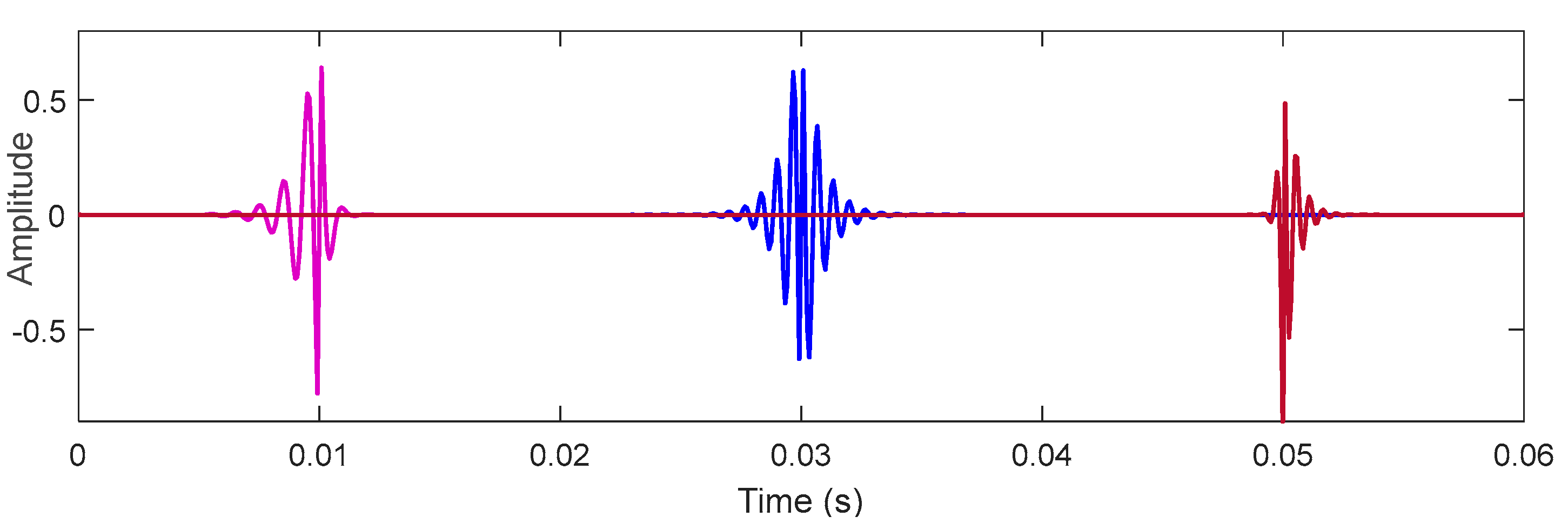
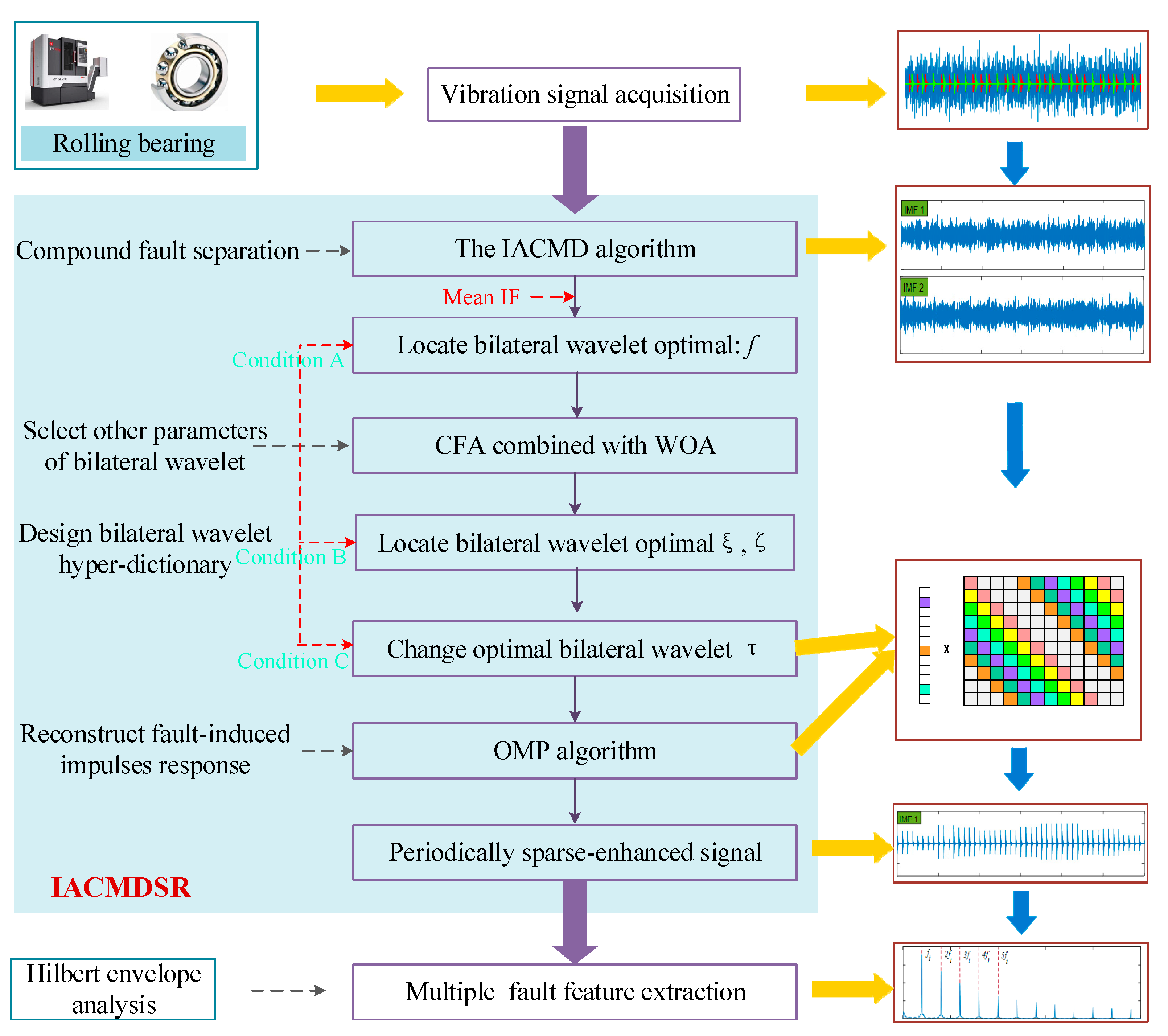
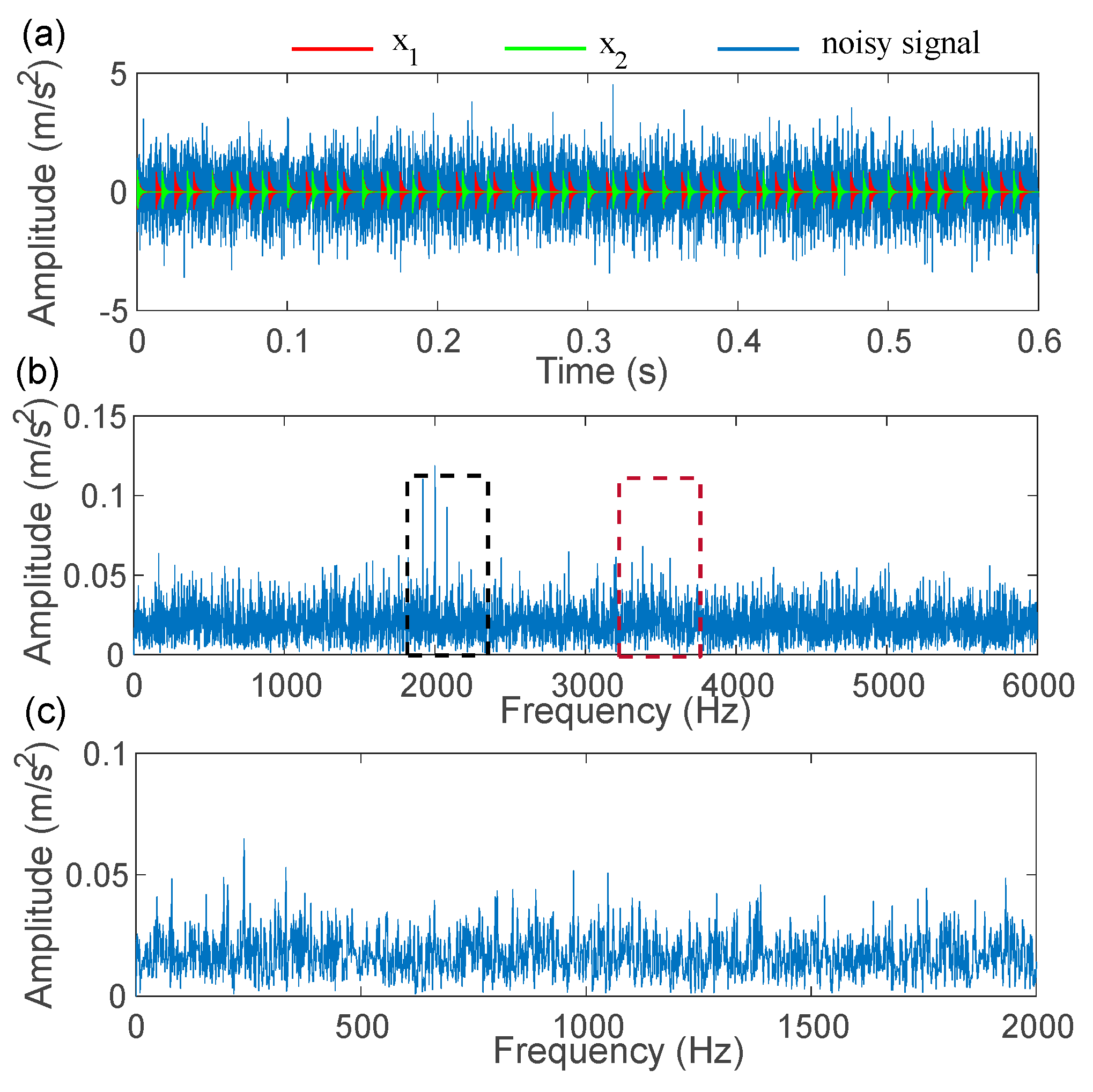
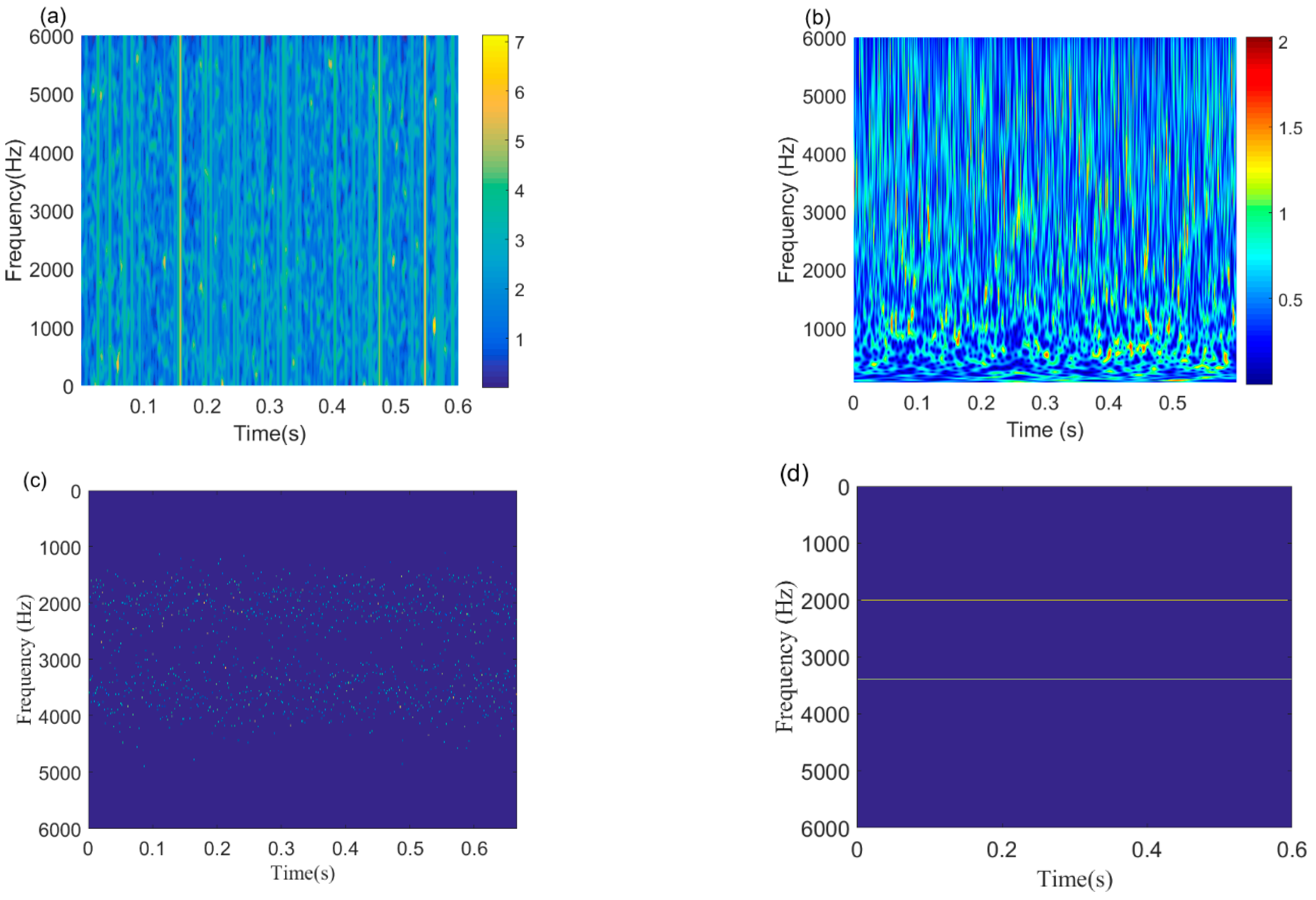
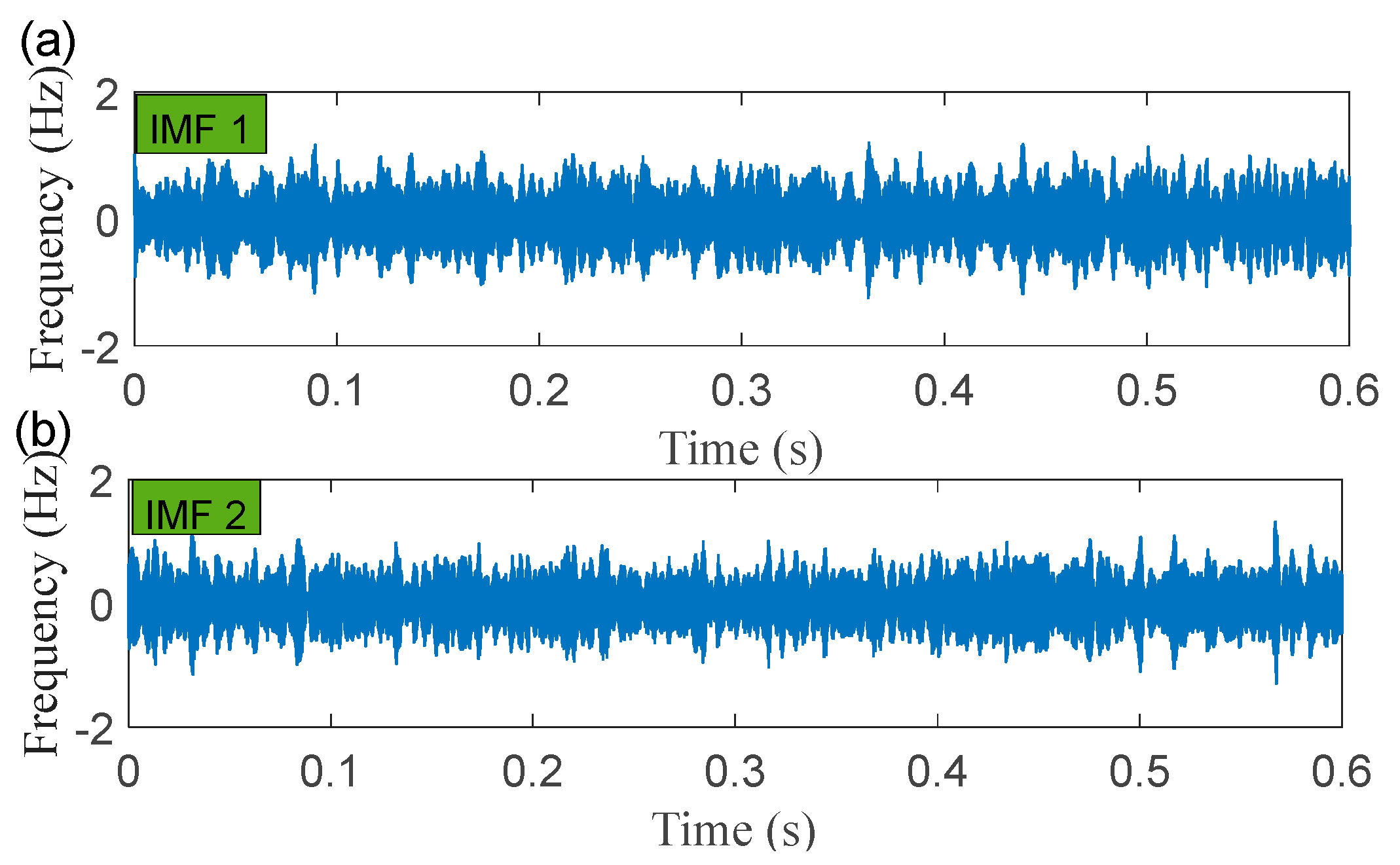
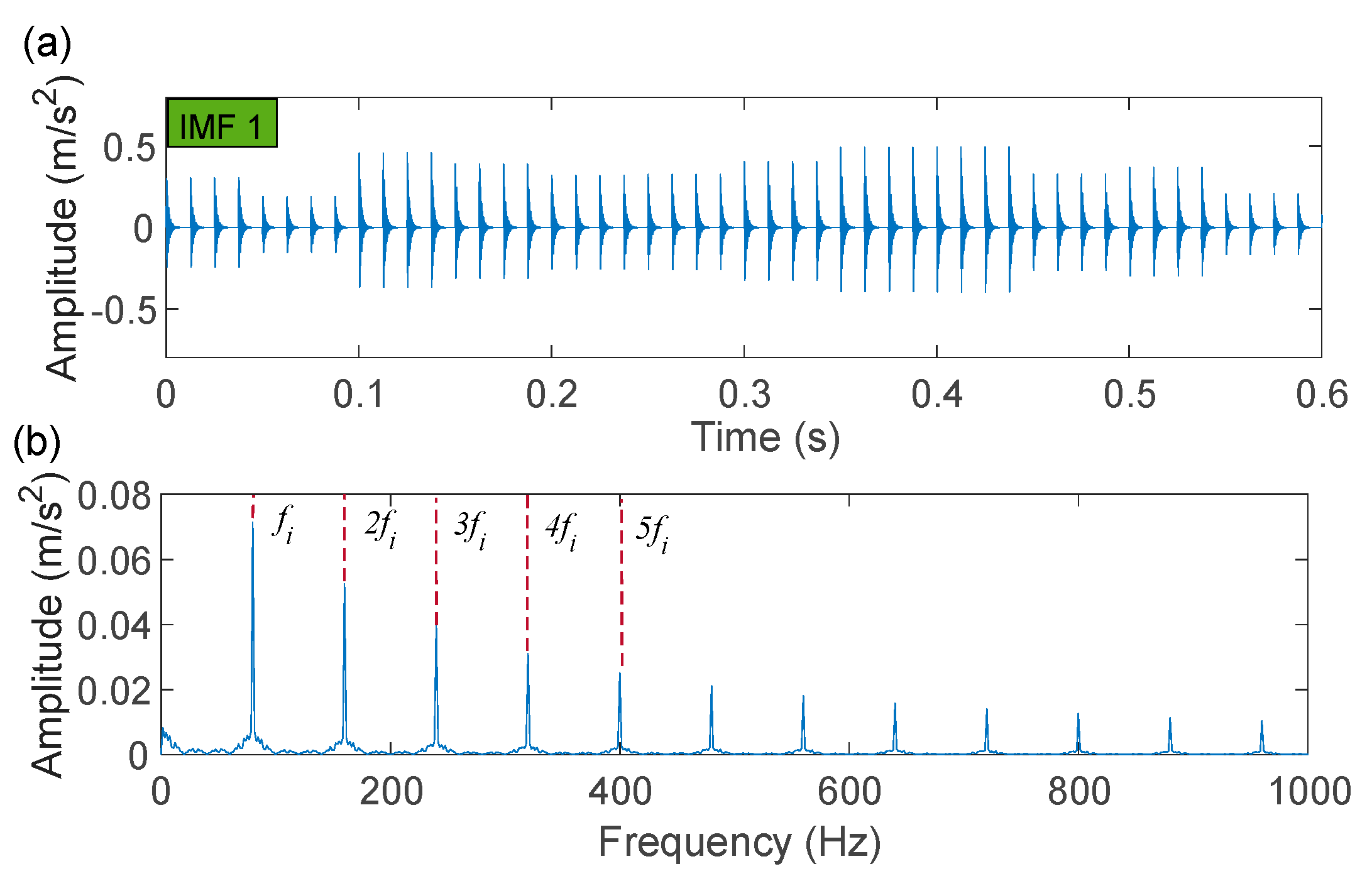
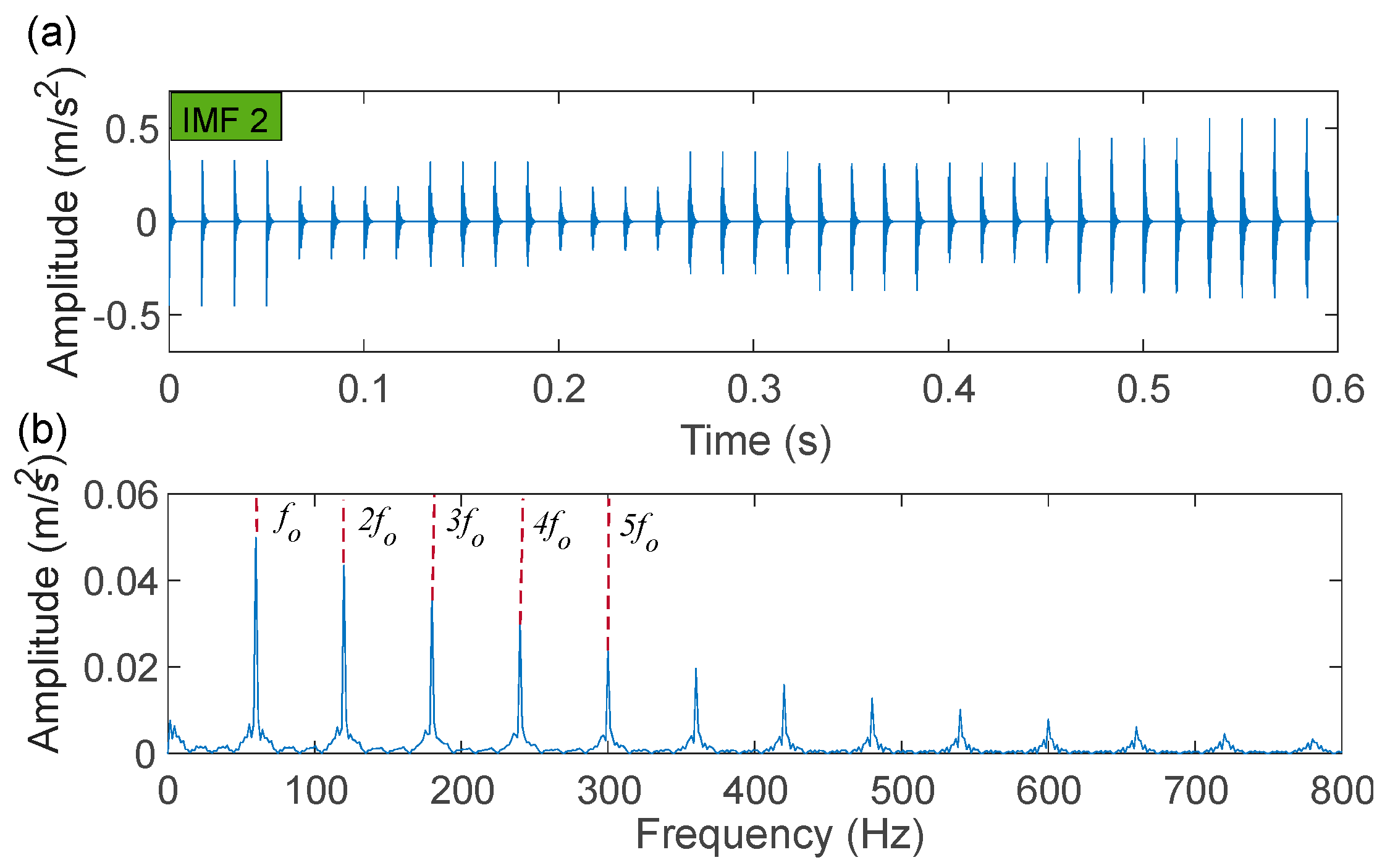


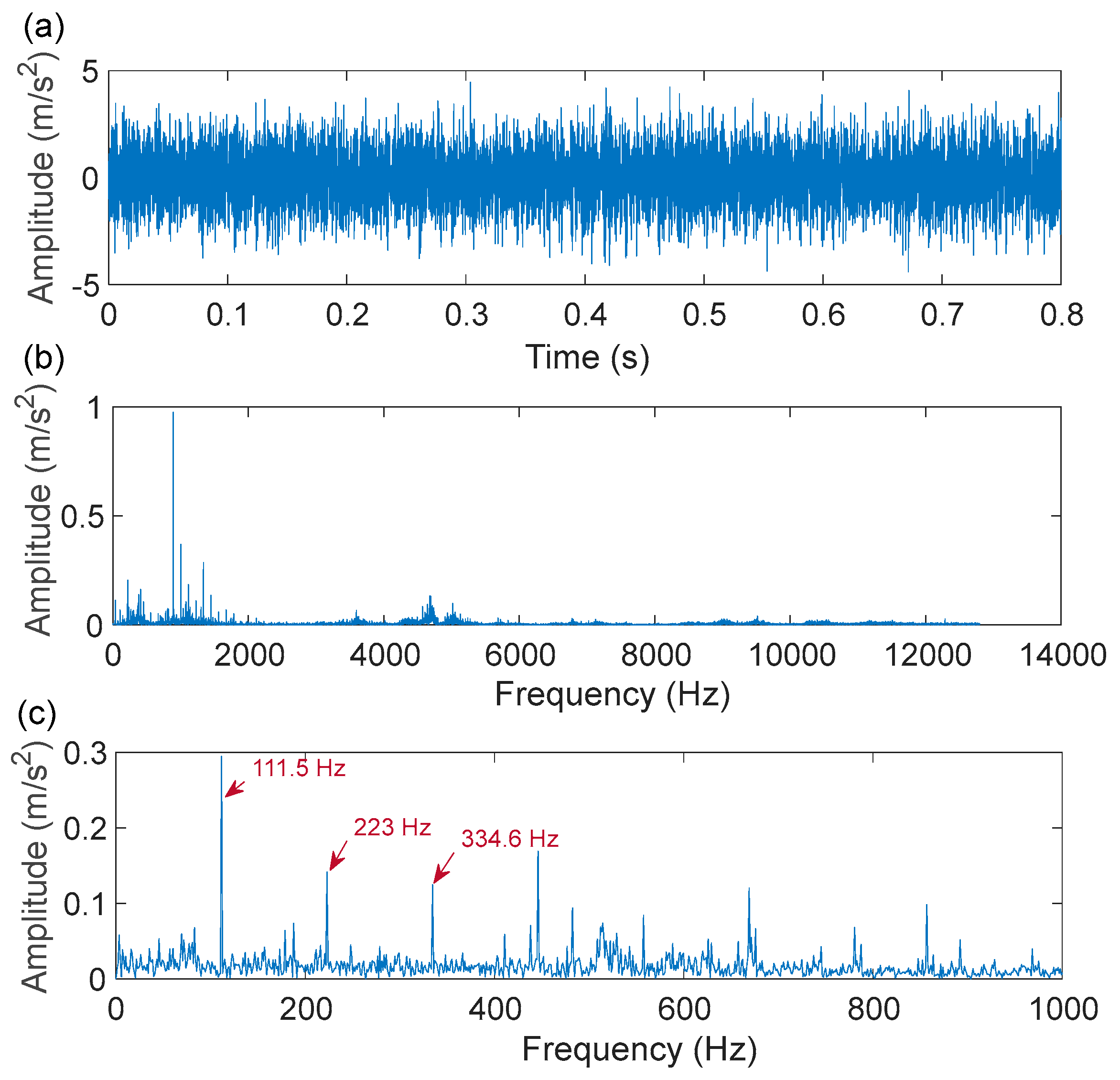

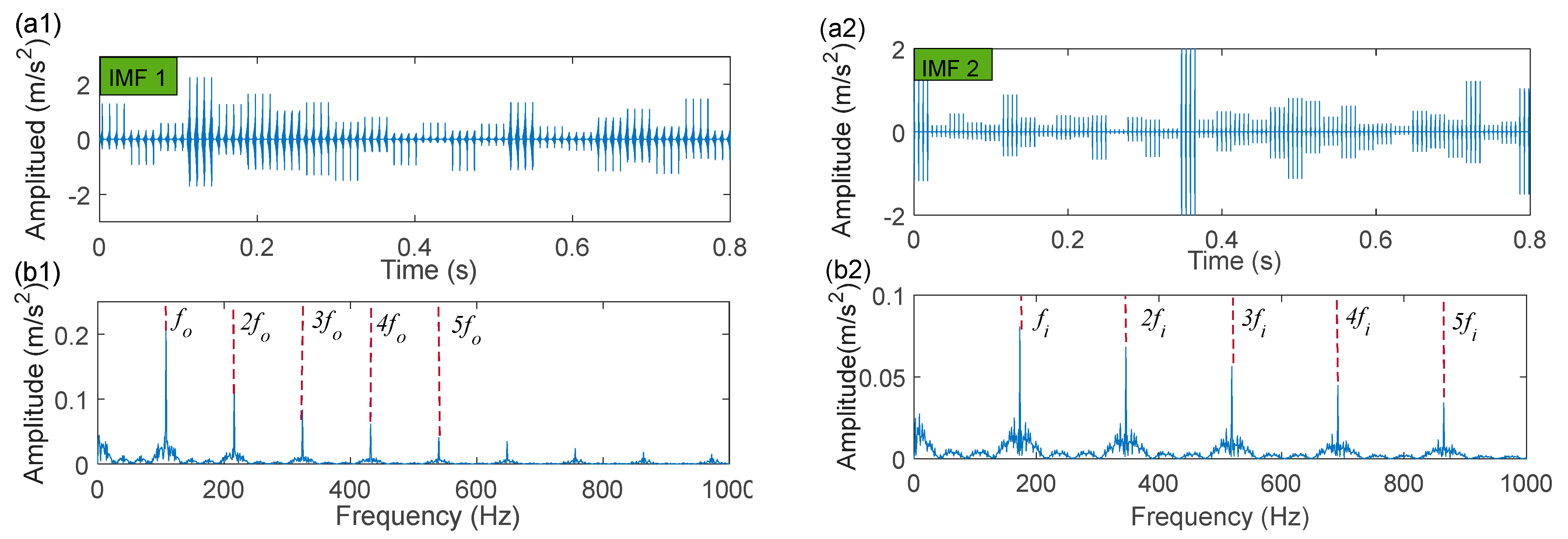



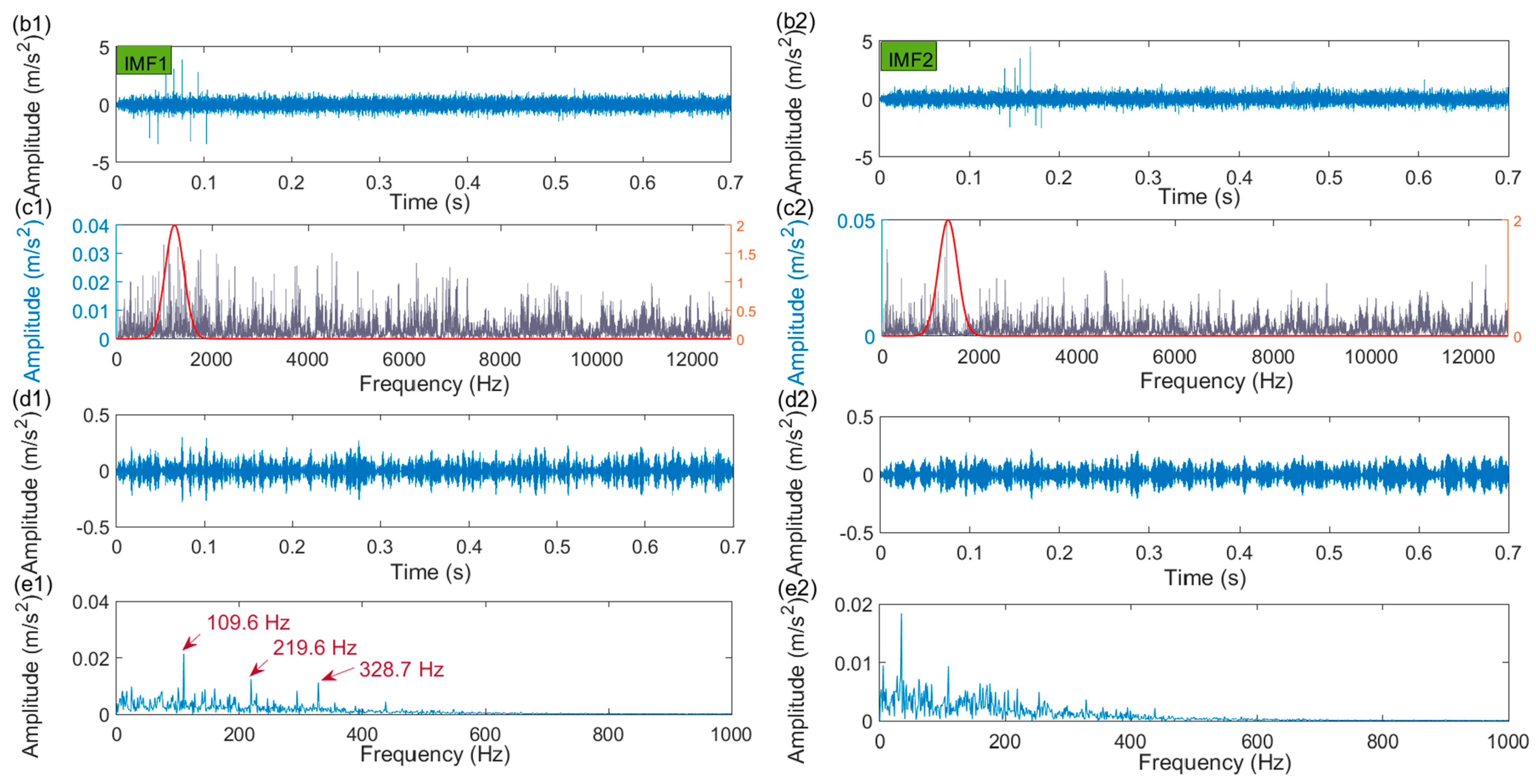
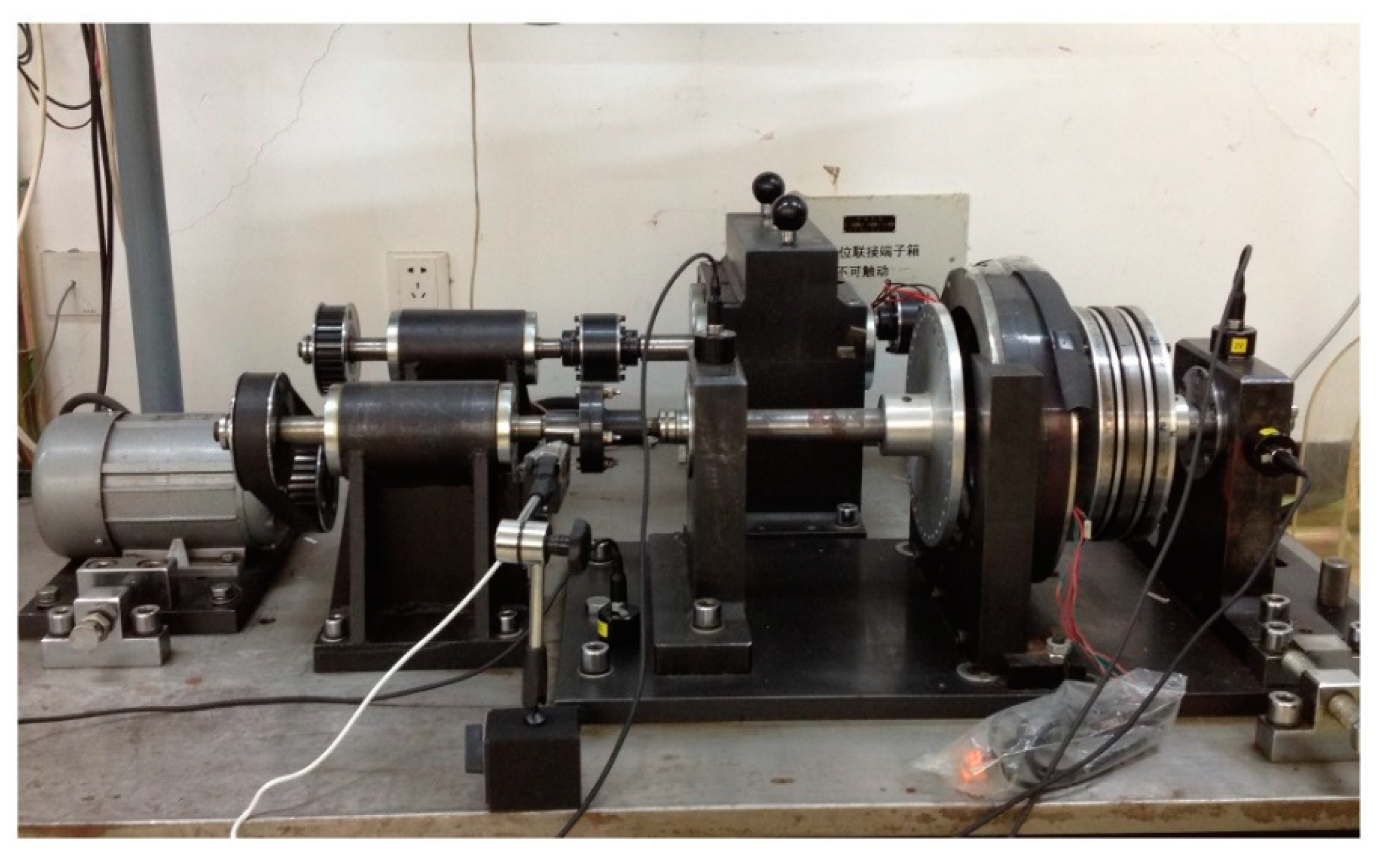
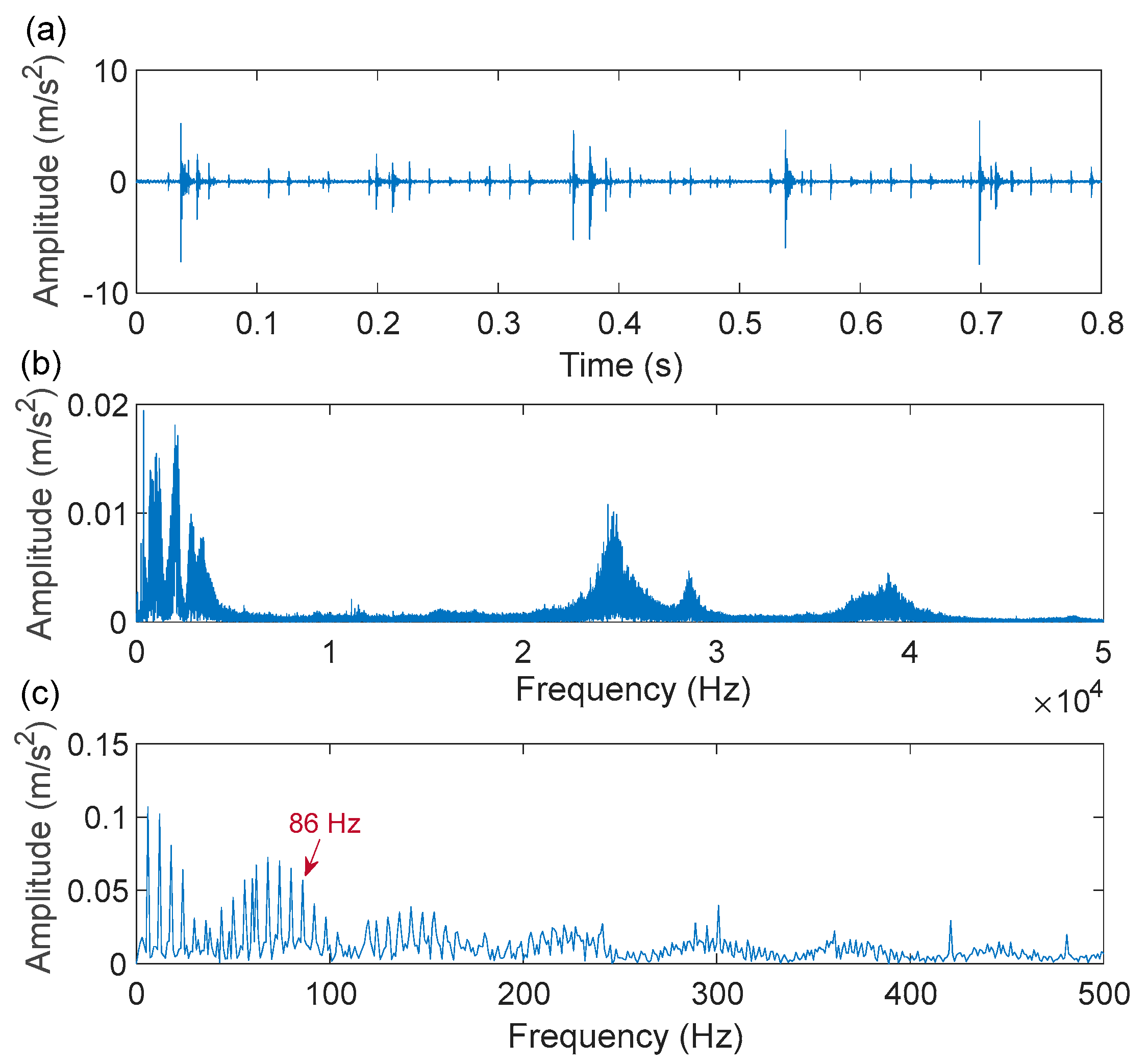
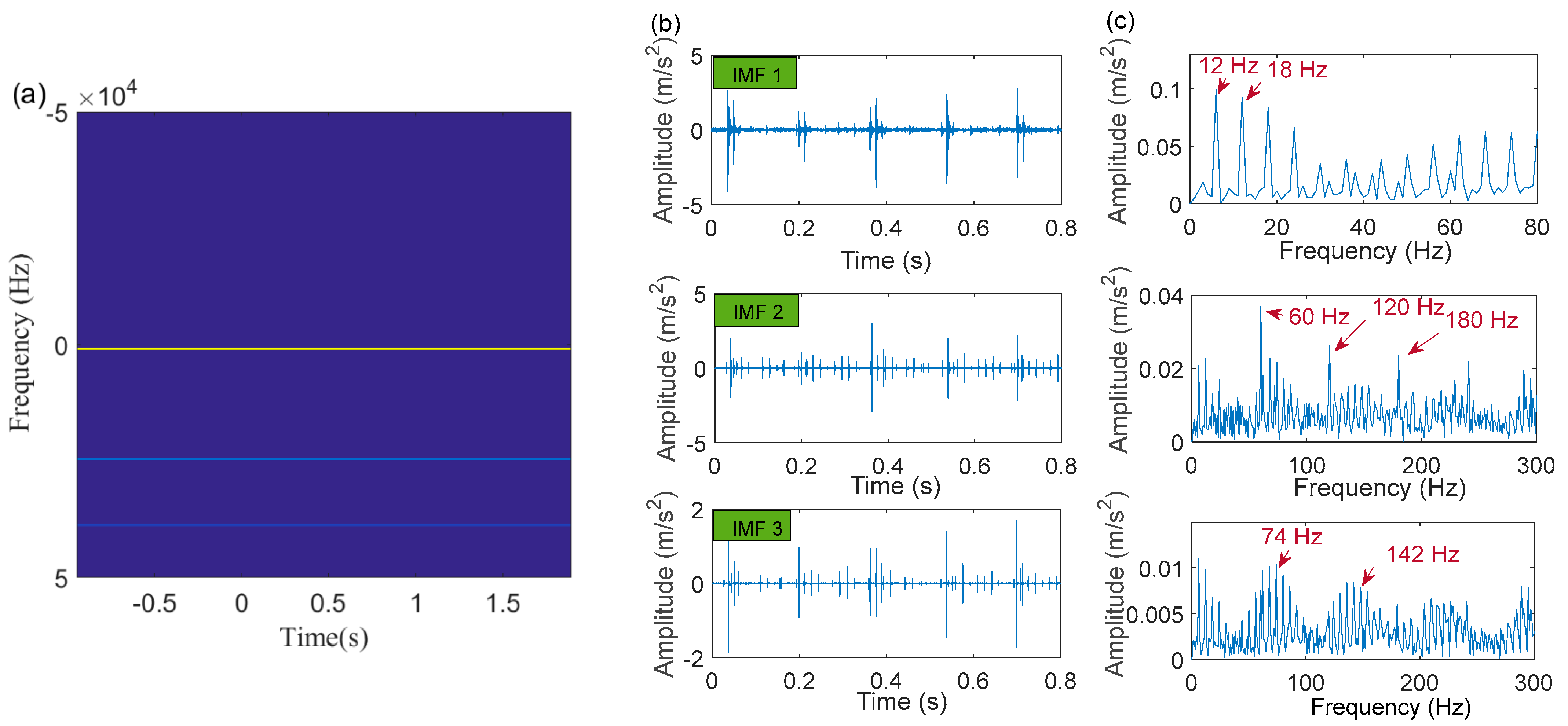

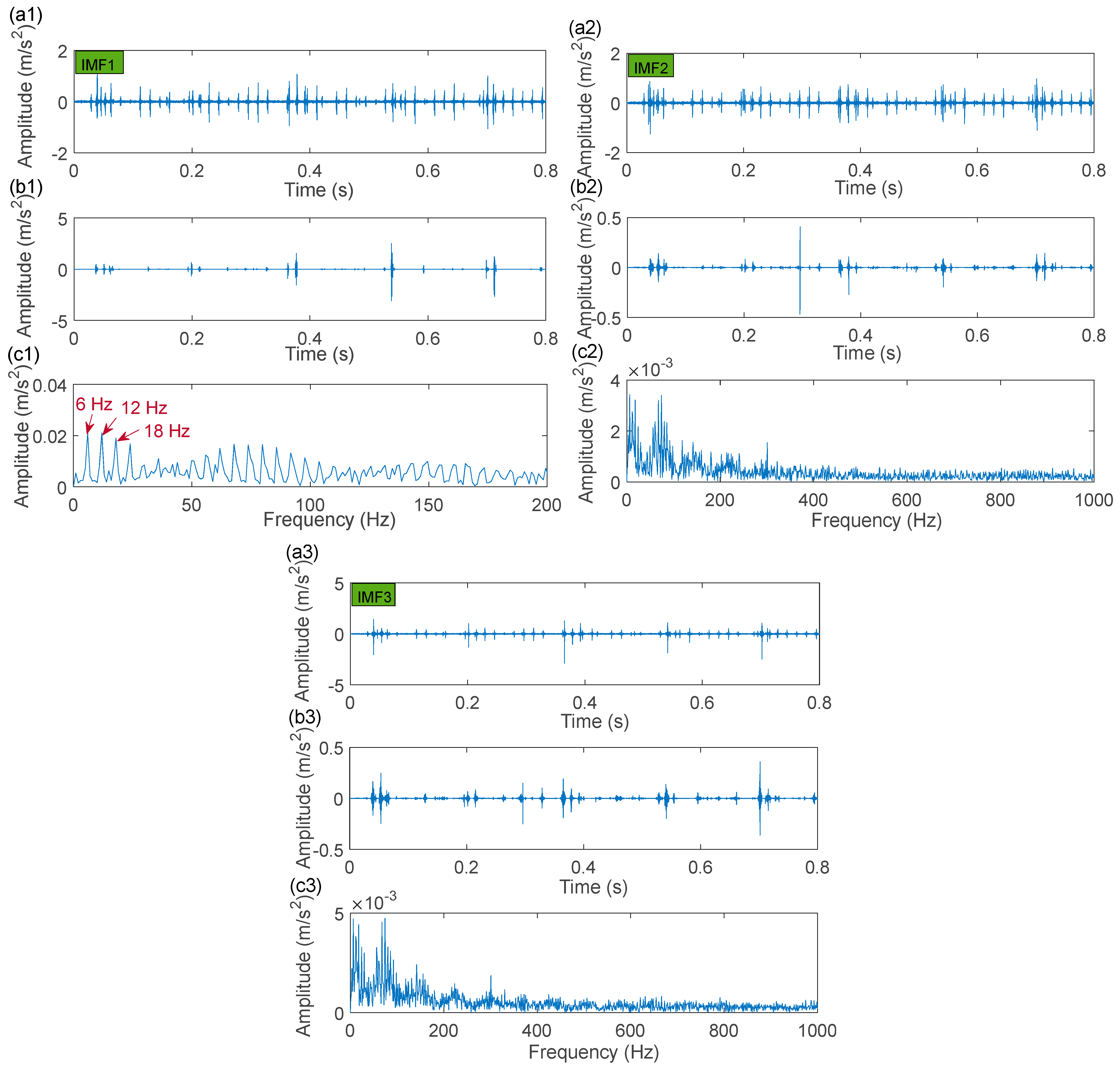

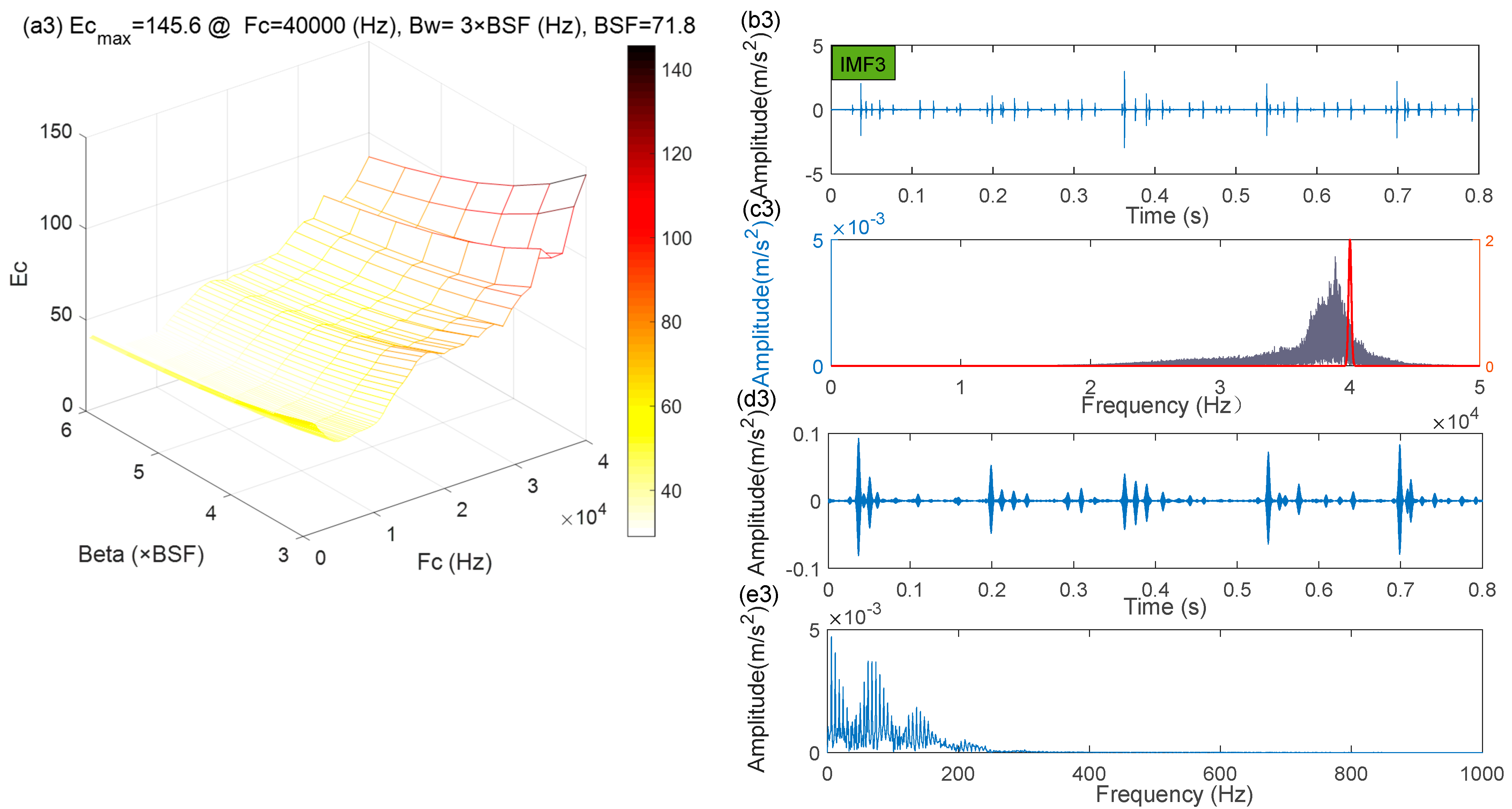
| Geometric Parameter | Numerical |
|---|---|
| Rolling diameter Dr (mm) | 7.92 |
| Inner ring raceway diameter Di (mm) | 29.30 |
| Outer race diameter Do (mm) | 39.8 |
| Bearing mean diameter (mm) | 34.55 |
| Contact angle (α/°) | 0 |
| Rollers number Z | 8 |
| Load rating (static) (kN) | 6.65 |
| Load rating (dynamic) (kN) | 12.82 |
| Geometric Parameter | Numerical |
|---|---|
| Inner race diameter Di (mm) | 20 |
| Outer race diameter Do (mm) | 47 |
| Contact angle (α/°) | 0 |
| Rollers number Z | 10 |
| Thickness (mm) | 14 |
Publisher’s Note: MDPI stays neutral with regard to jurisdictional claims in published maps and institutional affiliations. |
© 2022 by the authors. Licensee MDPI, Basel, Switzerland. This article is an open access article distributed under the terms and conditions of the Creative Commons Attribution (CC BY) license (https://creativecommons.org/licenses/by/4.0/).
Share and Cite
Zhang, L.; Zhao, L.; Wang, C.; Xiao, Q.; Liu, H.; Zhang, H.; Hu, Y. Multiple Enhanced Sparse Representation via IACMDSR Model for Bearing Compound Fault Diagnosis. Sensors 2022, 22, 6330. https://doi.org/10.3390/s22176330
Zhang L, Zhao L, Wang C, Xiao Q, Liu H, Zhang H, Hu Y. Multiple Enhanced Sparse Representation via IACMDSR Model for Bearing Compound Fault Diagnosis. Sensors. 2022; 22(17):6330. https://doi.org/10.3390/s22176330
Chicago/Turabian StyleZhang, Long, Lijuan Zhao, Chaobing Wang, Qian Xiao, Haoyang Liu, Hao Zhang, and Yanqing Hu. 2022. "Multiple Enhanced Sparse Representation via IACMDSR Model for Bearing Compound Fault Diagnosis" Sensors 22, no. 17: 6330. https://doi.org/10.3390/s22176330





